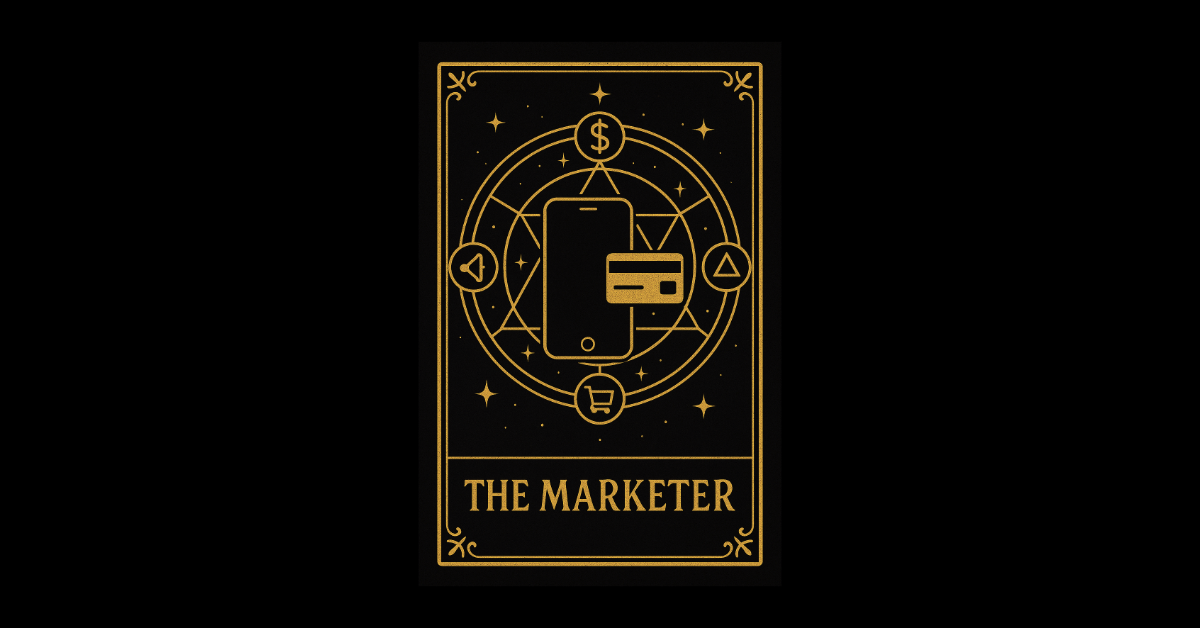
Marketing likes to present itself as rational. As science-like.
Data-driven, measurable, optimised. But scratch the surface and you’ll find something older and stranger underneath. A hidden practice. A ritual art. A system of symbols, belief, and persuasion. In other words: marketing begins to look a lot like the occult.
No, I’m not having a mental breakdown. Hear me out here.
Isn’t that literally what we marketers’ traffic in? Consumers don’t see the segmentation spreadsheets, the A/B tests, or the neurolinguistic copy tweaks. All they see are the effects: the compulsion to buy, the sense that this thing is somehow meant for them. Marketing is an invisible hand tugging at desire.
Occult practices have always leaned on ritual: chanting, repetition, small symbolic gestures meant to transform reality.
Marketing is built on the same principle.
A campaign is a spell cast at scale.
Repeat a logo enough times, it becomes etched into collective memory. Play a jingle long enough and it turns into an incantation, resurfacing unbidden in your head.
The unboxing video is a liturgy, complete with ceremonial tools: the box cutter, the tissue paper, the reveal.
A product launch is an initiation rite. Attendees gather, hear the words of the high priest (or CEO), witness the revelation of the sacred object, and walk away transformed.
You can almost hear the Gregorian chant swelling in the background of an Apple keynote lmfao.
Magicians of old talked about planetary alignments, ley lines, or spirits. Marketers talk about psychographics, lookalike audiences, and behavioural nudges. Both reassure us: don’t worry, we’ve studied the mysteries, we know what will work.
And both ask for faith. Consumers don’t need to understand the mechanism; they just need to feel the effect. Like an astrologer divining your fate from a birth chart, a marketer divines your future from your clicks. The technique may be hidden, but the prophecy lands: this is for you.
Symbols and archetypes
Magic has its talismans and sigils. Marketing has logos and mascots. Both are visual shorthand for entire mythologies. The Nike swoosh isn’t just a check mark. It’s victory, transcendence, divine motion. The Starbucks mermaid is an oceanic spirit who guides you toward your morning ritual.
Brand strategists borrow straight from Jungian archetypes: the Hero, the Trickster, the Caregiver. So did occultists. Myth is portable, and both traditions know it.
You don’t need to believe in Hermes or Mercury to trust a shipping company called FedEx. The winged symbol does the work. Symbols compress story into a single mark. That’s magic. That’s marketing.
Community as coven
No ritual works alone. You need a circle, a coven, a congregation. Brands know this better than anyone. The Stanley Cup isn’t a tumbler; it’s membership. Glossier, not makeup; but discipleship. Peloton riders literally call themselves a tribe.
Buy the product, learn the lingo, join the group chat.
Initiation through purchase. Identity through ritual. The community becomes self-sustaining, complete with hierarchies (early adopters vs. latecomers), relics (limited edition drops), and sacred spaces (the flagship store, the Discord channel, the TikTok hashtag).
It’s not only about what the product does. It’s about what the product means within the circle. A rosary is merely beads until it’s prayed on. A Stanley, just steel until it’s shared on Instagram.
A long tradition
If all of this feels contemporary: the astrology memes, the crystal-branded face serums, the tarot-inspired packaging, remember it’s not new.
In the 19th century, patent medicines were literally sold as tonics, elixirs, miracle cures. Posters promised radiant health with illustrations that glowed like religious icons. Early soap ads promised spiritual purity along with cleanliness.
By the 1950s, advertising was openly described as a priesthood. Vance Packard’s The Hidden Persuaders painted Madison Avenue as a coven of manipulators who knew the secret buttons of the psyche. They didn’t just sell soap; they sold salvation, romance, redemption.
The occult aesthetic that saturates today’s marketing isn’t an ironic Tumblr-era trend. It’s the continuation of a very old relationship between commerce and magic.
So why the resurgence now, especially among millennials and Gen Z?
Part of it is disillusionment. Everything is flattened by the algorithm, stripped of mystery, gamified and optimised. Life feels disenchanted.
The occult offers a re-enchantment. It promises mystery, symbolism, ritual. Even if you don’t believe in astrology, the ritual of reading a horoscope or pulling a tarot card gives texture to the day. Likewise, buying a face serum that calls itself an elixir feels like participating in a small spell of transformation.
Brands know this hunger. That’s why we see moon phases on packaging, zodiac-themed drops, and campaigns that talk about “manifestation” or “unlocking your abundance.” These aren’t just aesthetic choices; they’re attempts to position the brand as a provider of ritual and meaning in a landscape where both are scarce.
The spell that works
And maybe that’s the real insight. Maybe I’ve gone too far down a rabbit hole. But the way I see it, marketing doesn’t just borrow from the occult. It is the hidden art of modern capitalism. A system of rituals, symbols, and archetypes designed to conjure belief, transform perception, and bind people into communities.
Marketers are the magicians of our age, casting spells not with wands but with copy, design, and data. The altar is the checkout screen. The offering is your credit card. The transformation is that moment of belonging when you feel, however briefly, like the product has changed you.
Call it witchcraft. Call it branding. Either way, you can’t deny that the spell works.
-Sophie Randell, Writer
Not going viral yet?
We get it. Creating content that does numbers is harder than it looks. But doing those big numbers is the fastest way to grow your brand. So if you’re tired of throwing sh*t at the wall and seeing what sticks, you’re in luck. Because making our clients go viral is kinda what we do every single day.
